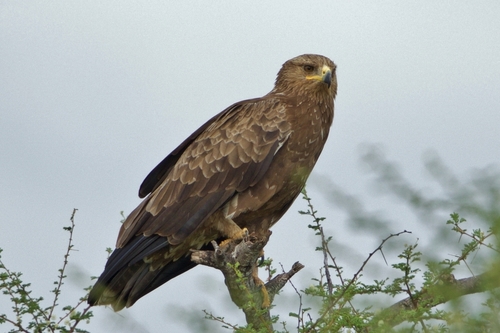
Lesser Spotted Eagle
The Lesser Spotted Eagle (*Clanga pomarina*) is a medium-sized bird of prey known for its distinctive spotted plumage during its juvenile phase. It plays a crucial role in its ecosystem as a predator of small mammals, reptiles, and amphibians, helping to regulate prey populations. While not holding significant cultural symbolism in many regions, it is a valued indicator species of healthy forest and wetland habitats. It is part of the broader group of spotted eagles, which also contains the greater spotted eagle and Indian spotted eagle.
55-65 cm
Length
145-168 cm
Wingspan
Least Concern
Conservation Status
Distribution
Breeds primarily in Central and Eastern Europe, extending eastward into parts of Russia and Turkey. Migrates to eastern and southern Africa for the winter, covering significant distances. Altitudinal range varies from lowlands to mountainous regions up to 2,200 meters.
Lifespan
Typically 10-15 years in the wild, potentially longer in captivity. (Consult a professional for expert advice)
Lesser Spotted Eagle's Habitat
Habitat Types
Mixed forests, Woodlands near wetlands, Agricultural areas with hedgerows, Marshlands
Climate Zones
Temperate, Boreal
Adaptations
Prefers habitats with a mosaic of open areas for hunting and forested areas for nesting. Their broad wings are adapted for soaring flight, allowing them to cover large distances during migration and hunting.
Variations
No clearly defined subspecies are widely recognized, although some minor plumage variations may occur across its broad range.
Appearance
Breeding Plumage
Adult plumage is generally dark brown above and slightly paler below. Juveniles have more pronounced spotting on the upperparts, which fades with age.
Seasonal Feather Changes
Limited seasonal variation; plumage is more worn after the breeding season.
Sex Based Plumage Differences
Minimal sexual dimorphism in plumage; females may be slightly darker.
Notable Features
Relatively small head for an eagle, Yellow cere and feet, Dark brown eyes
Diet and Feeding
Primary Foods
Small mammals (voles, mice), Amphibians (frogs), Reptiles (lizards, snakes), Small birds, Large insects
Foraging Behavior
Hunts primarily by soaring and scanning the ground from a moderate height, or by perching on trees or posts. Occasionally hunts on foot.
Specializations
Adaptable to a variety of prey, allowing it to thrive in different habitats.
Seasonal Diet Variations
Diet may shift depending on prey availability; for example, consuming more amphibians during wet seasons.
Behavior
Social Structure
Generally solitary or in pairs during the breeding season. May form small flocks during migration.
Communication
A high-pitched 'kee-kee-kee' call, Soaring displays, Vocalizations near the nest
Migration
Long-distance migrant, traveling between breeding grounds in Europe and wintering grounds in Africa. Migration routes are influenced by geographic features and weather patterns.
Territorial or Group Behaviors
Territorial during the breeding season, defending the nesting area from other eagles and predators.
Conservation
Threats
Habitat loss and degradation (deforestation, agricultural intensification), Collision with power lines, Illegal hunting and persecution, Climate change (affecting prey availability and migration patterns)
Protection Programs
Protected under various international agreements (e.g., Bonn Convention, Bern Convention), Habitat restoration projects, Monitoring programs to track population trends
Local National Laws
Protected under national wildlife laws in many European and African countries.
Population Trend
Stable, but with regional variations.
Population Estimates
The global population is estimated to be 40,000-60,000 individuals.
Interesting Facts
They are known for their strong migratory behavior.
Lesser Spotted Eagles undertake impressive long-distance migrations between Europe and Africa.
They often reuse the same nest for several years.
This behavior, known as nest site fidelity, is common in many raptor species.
The Lesser Spotted Eagle hybridizes with the Greater Spotted Eagle.
Hybridization can make field identification difficult, but it occurs where their ranges overlap.
Faqs about Lesser Spotted Eagle
What is the main difference between Lesser Spotted Eagles and Greater Spotted Eagles?
Lesser Spotted Eagles are generally smaller and have less prominent spotting in adult plumage. Genetic testing is now commonly used to distinguish the species.
How can I help protect Lesser Spotted Eagles?
Supporting conservation organizations that work to protect their habitats and reduce threats like illegal hunting is a good way to help.
Where can I see a Lesser Spotted Eagle?
During the breeding season, they can be found in suitable habitats in Central and Eastern Europe. During migration, they may be seen along migration routes through the Middle East and into Africa.
Copyright @ Nature Style Limited. All Rights Reserved.
 English
English